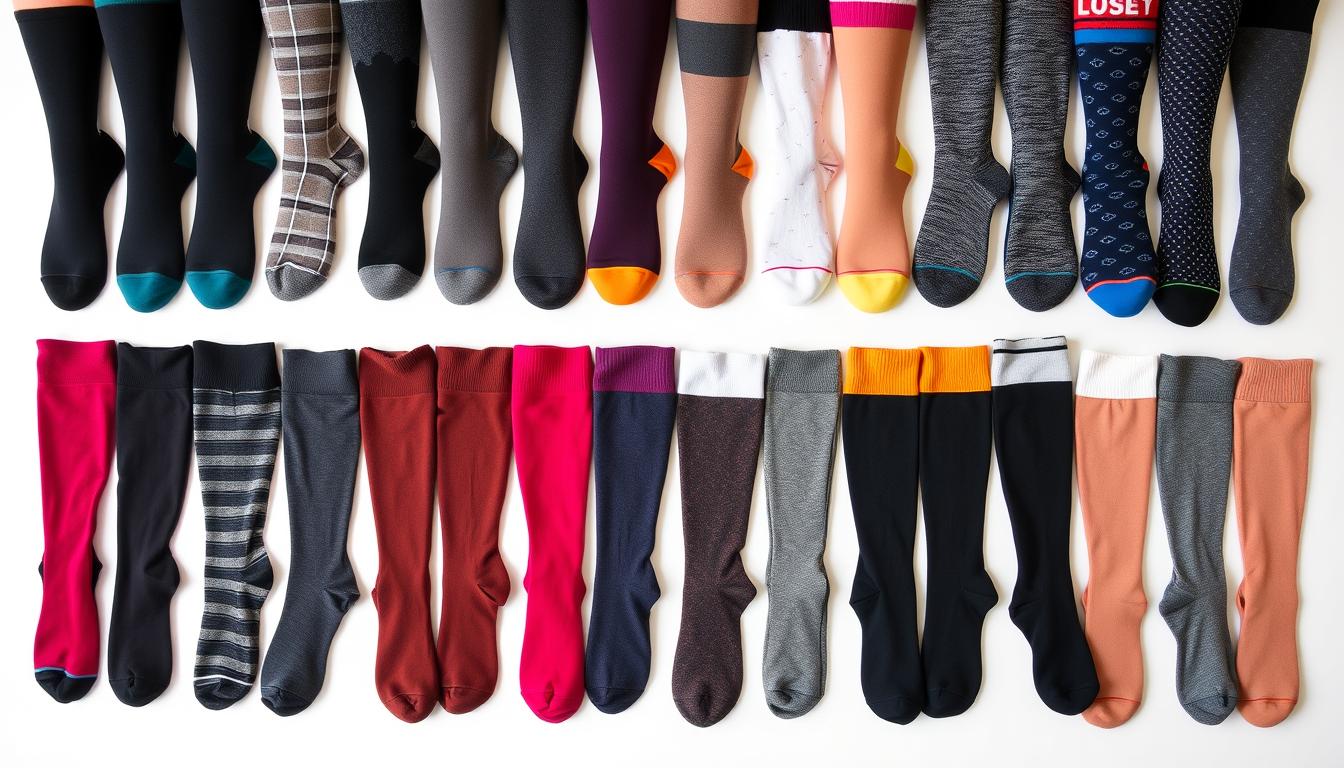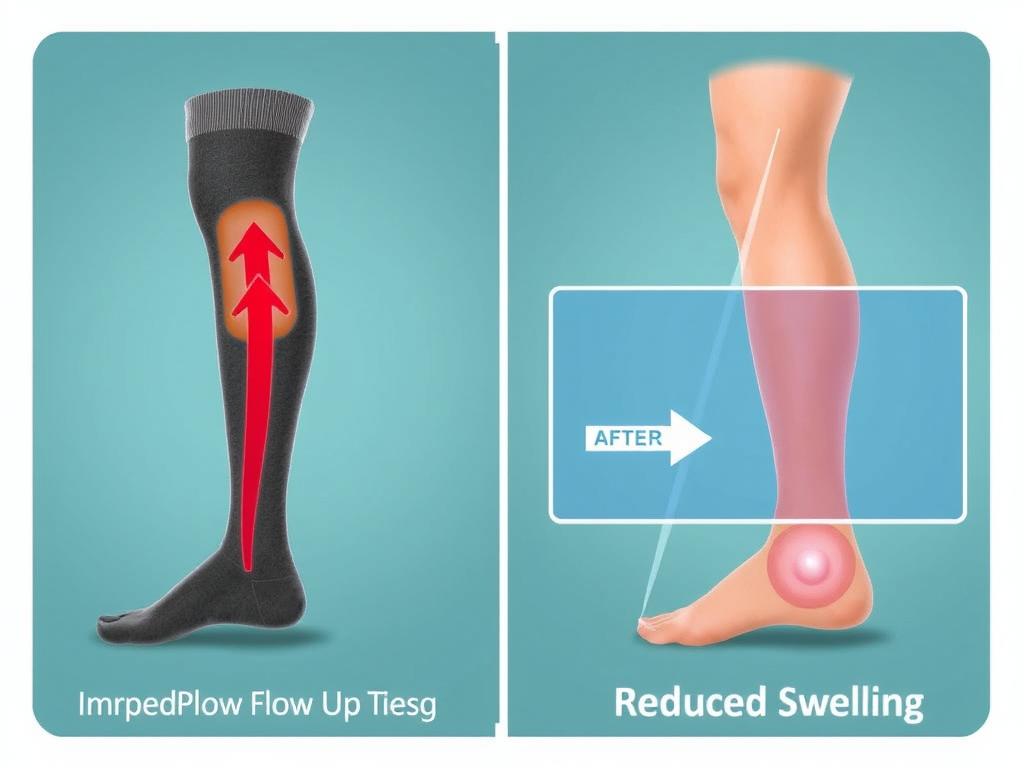

Women’s knee high support socks have evolved from purely medical devices to versatile accessories that combine function with fashion. Whether you’re an athlete seeking enhanced performance, a traveler looking to prevent swelling during long flights, or someone managing circulation issues, these specialized socks offer remarkable benefits. This comprehensive guide explores everything you need to know about choosing and using knee high support socks to improve your comfort and health.
Understanding the advantages of compression socks can help you determine if they’re right for your needs. These specialized garments offer multiple benefits beyond basic foot coverage.
The graduated compression in knee high support socks is tightest at the ankle and gradually decreases up the leg. This design helps blood flow upward against gravity, preventing pooling in the lower extremities. For women who stand or sit for extended periods, this improved circulation can significantly reduce swelling and discomfort.


Athletes and active women benefit from the muscle support provided by compression stockings. The gentle pressure helps stabilize muscles during activity and can reduce vibration, which contributes to fatigue. Studies show that wearing compression socks during and after exercise may improve performance and speed recovery time.
One of the greatest advantages of modern knee-high support stockings is their versatility. Medical-grade compression socks help manage conditions like varicose veins and edema, while travel-specific designs reduce the risk of deep vein thrombosis during long flights. For pregnant women, specialized compression socks can alleviate leg discomfort associated with pregnancy.
Gone are the days when compression socks came only in clinical beige. Today’s women’s knee high support socks come in countless colors, patterns, and materials. From subtle neutrals that blend with business attire to bold patterns for making a statement, you can find compression socks to match any outfit or occasion.
Discover how the right pair of support socks can transform your comfort and health.
Not all compression socks are created equal. Understanding the key features will help you select the perfect pair for your specific needs.
Compression strength is measured in millimeters of mercury (mmHg), indicating the pressure applied to your legs. Here’s what each level offers:
| Compression Level | Pressure (mmHg) | Best For |
| Light | 8-15 mmHg | Everyday wear, mild swelling, travel |
| Medium | 15-20 mmHg | Sports, pregnancy, long periods of standing |
| Firm | 20-30 mmHg | Varicose veins, post-surgery, moderate edema |
| Extra Firm | 30-40 mmHg | Severe edema, lymphedema (usually requires prescription) |
The fabric blend significantly impacts comfort, durability, and functionality:
Quality knee high support socks often feature silicone bands at the top to prevent slipping or rolling down. This feature is particularly important for active women or those who will be wearing their socks for extended periods. The best designs provide secure hold without digging into the skin or causing discomfort.
A seamless toe box prevents friction and irritation, especially important for those with sensitive feet or diabetes. This design feature eliminates the uncomfortable ridge that can cause blisters or pressure points during extended wear. Look for reinforced toe areas for additional durability in high-wear zones.
The right features make all the difference in comfort and effectiveness.
Selecting the perfect pair of compression socks depends on your specific needs, activities, and preferences. Follow these guidelines to make the best choice.
Proper sizing is crucial for effective compression. Too tight, and the socks can restrict circulation; too loose, and they won’t provide adequate support.
Pro Tip: If you fall between sizes, it’s usually better to size up rather than down. Many brands also offer wide-calf options for more comfortable fit.
Now that you know what to look for, discover our top recommended brands.
After extensive research and testing, we’ve identified the best brands offering quality, comfort, and effectiveness for various needs and budgets.
Vim & Vigr stands out for combining medical-grade compression with fashion-forward designs. Their socks come in multiple fabrics (cotton, nylon, wool) and compression levels (15-20mmHg and 20-30mmHg). What sets them apart is their vast array of patterns and colors that make compression socks feel like a style choice rather than a medical necessity.
Jobst is the gold standard for medical-grade compression stockings. Their products are often recommended by healthcare providers for managing various circulatory issues. They offer precise compression levels from 8-15mmHg up to 30-40mmHg, with options for open or closed toe. While style isn’t their primary focus, they’ve expanded their color options beyond basic beige.
Bombas has built a reputation for exceptional comfort and performance in their athletic compression socks. Their knee-high options feature strategic cushioning, seamless toe boxes, and honeycomb arch support. While they offer moderate compression (generally 15-20mmHg), their focus is on athletic performance and recovery rather than medical-grade compression.
SB SOX offers quality compression socks at a significantly lower price point than premium brands. Their 20-30mmHg knee-high options provide good graduated compression for everyday use, travel, and light athletic activities. While they may not match the durability of higher-end brands, they offer excellent value for those new to compression socks or needing multiple pairs.
Designed specifically for healthcare professionals who stand for 12+ hour shifts, Nurse Mates compression socks excel at all-day comfort. Their 12-14mmHg compression level is mild enough for beginners while still providing meaningful support. They feature extra cushioning in high-impact areas and antimicrobial properties to keep feet fresh through long shifts.
The right compression socks can make a significant difference in your comfort and health.
Proper care extends the life of your compression socks and maintains their effectiveness. Follow these guidelines to get the most from your investment.
Even with proper care, compression socks will eventually lose their elasticity and effectiveness. Here’s when to replace them:
| Usage Frequency | Recommended Replacement | Signs It’s Time to Replace |
| Daily wear | Every 3-6 months | Loosening at ankle, sagging, loss of compression |
| 2-3 times per week | Every 6-9 months | Thinning fabric, stretched cuff, fading compression |
| Occasional use | Every 9-12 months | Visible wear, holes, inconsistent pressure |
Pro Tip: Rotate between 2-3 pairs of compression socks to extend their lifespan and ensure you always have a clean pair available.
Generally, it’s not recommended to sleep in compression socks unless specifically directed by a healthcare provider. Nighttime is when your legs naturally recover, and constant compression can potentially interfere with this process. However, there are specific compression garments designed for nighttime use that provide gentler pressure. If you have a medical condition that might benefit from overnight compression, consult with your doctor for personalized advice.
People with diabetes should exercise caution with compression socks. While mild compression (8-15mmHg) may be beneficial for some diabetics, stronger compression can potentially restrict circulation in those with peripheral neuropathy or arterial issues. Always consult with your healthcare provider before using compression socks if you have diabetes. If approved, look for seamless designs specifically made for diabetic comfort, and monitor your feet regularly for any signs of irritation or circulation problems.
Properly fitted compression socks should feel snug but not painful. They should be tightest at the ankle and gradually looser as they move up the leg. You should be able to fit two fingers under the band at the top. If your socks leave deep indentations in your skin, cause numbness, tingling, or pain, they’re too tight. Conversely, if they slide down or wrinkle, they’re too loose. Finding the right balance is essential for both comfort and effectiveness.
Yes, there are open-toe compression socks specifically designed to be worn with sandals or open-toe shoes. These provide the same graduated compression benefits while leaving your toes free. They’re particularly popular in warmer weather or for those who find closed-toe compression socks too constricting around the toes. Many major brands offer open-toe options in their knee-high compression sock lines.
For most people, wearing compression socks during waking hours (typically 12-16 hours) is sufficient. Put them on in the morning when swelling is minimal and remove them before bed. However, optimal wearing time varies based on your specific needs and condition. Those new to compression socks might start with shorter periods (4-6 hours) and gradually increase. Always follow your healthcare provider’s recommendations if you’re wearing them for a medical condition.
Women’s knee high support socks have evolved from purely medical devices to versatile accessories that combine health benefits with style and comfort. Whether you’re an athlete seeking enhanced performance, a professional who stands all day, or someone managing circulation issues, the right compression socks can make a significant difference in how your legs feel at the end of the day.
Remember to consider your specific needs when choosing compression level, material, and features. Proper sizing is crucial for both comfort and effectiveness, so take accurate measurements and consult size charts before purchasing. With proper care, your compression socks will provide reliable support for months of regular use.
As compression technology continues to advance, we’re seeing more options that combine effective support with fashionable designs, making it easier than ever to incorporate these beneficial garments into your daily wardrobe. Your legs will thank you for the improved circulation, reduced fatigue, and overall comfort that quality knee high support socks provide.
Explore our top recommended brands and find the perfect pair for your needs.
Table of Contents Introduction Understanding Knee Pain Triggers How Smartwatch Technology Monitors Knee Pain Top…
Discover how to alleviate knee pain after sleeping on side with our expert guide. Learn…
Discover the causes and treatments for knee pain when bending but not swelling. We explore…
Knee pain relief for nurses is achievable. We share our expertise on managing knee pain,…
We provide a comprehensive guide on knee-friendly elliptical workouts, helping you achieve your fitness goals…
We outline the 15 acupuncture points for knee bursitis that are most effective. Find out…